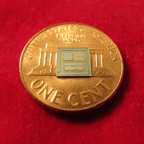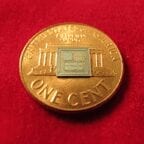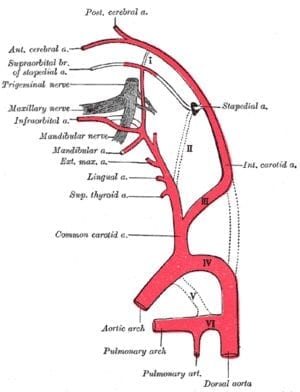
The U.S. Military relies on the space-based Global Positioning System (GPS) to aid air, land and sea navigation.
Like the GPS units in many automobiles today, a simple receiver and some processing power is all that is needed for accurate navigation. But, what if the GPS satellites suddenly became unavailable due to malfunction, enemy action or simple interference, such as driving into a tunnel? Unavailability of GPS would be inconvenient for drivers on the road, but could be disastrous for military missions. DARPA is working to protect against such a scenario, and an emerging solution is much smaller than the navigation instruments in today’s defense systems.
DARPA researchers at the University of Michigan have made significant progress with a timing & inertial measurement unit (TIMU) that contains everything needed to aid navigation when GPS is temporarily unavailable. The single chip TIMU prototype contains a six axis IMU (three gyroscopes and three accelerometers) and integrates a highly-accurate master clock into a single miniature system, smaller than the size of a penny. This chip integrates breakthrough devices (clocks, gyroscopes and accelerometers), materials and designs from DARPA’s Micro-Technology for Positioning, Navigation and Timing (Micro-PNT) program.
Three pieces of information are needed to navigate between known points ‘A’ and ‘B’ with precision: orientation, acceleration and time. This new chip integrates state-of-the-art devices that can measure all three simultaneously. This elegant design is accomplished through new fabrication processes in high-quality materials for multi-layered, packaged inertial sensors and a timing unit, all in a tiny 10 cubic millimeter package. Each of the six microfabricated layers of the TIMU is only 50 microns thick, approximately the thickness of a human hair. Each layer has a different function, akin to floors in a building.
“Both the structural layer of the sensors and the integrated package are made of silica,” said Andrei Shkel, DARPA program manager. “The hardness and the high-performance material properties of silica make it the material of choice for integrating all of these devices into a miniature package. The resulting TIMU is small enough and should be robust enough for applications (when GPS is unavailable or limited for a short period of time) such as personnel tracking, handheld navigation, small diameter munitions and small airborne platforms.”
The Latest Bing News on:
Extreme Miniaturization
- CDC warns of extreme heat dangers amid ‘record-breaking high temperatures’on April 19, 2024 at 10:29 am
Many regions across the United States experienced "record-breaking high temperatures" in 2023 due to extreme heat, according to the Centers for Disease Control and Prevention (CDC). Emergency room ...
- Extreme Networks: Back For Another Lookon April 14, 2024 at 9:26 am
The stock of Extreme Networks has fallen sharply recently due to a falloff in equipment sales blamed on distribution adjusting inventory levels following Covid shortages. However, the company is ...
- Trump’s extreme rhetoric is a mainstay of his 2024 campaign. Much of it could become a reality if he wins another termon April 13, 2024 at 4:00 am
In the more than 370 days between his first indictment and his first criminal trial, Donald Trump unleashed rhetorical warfare as predictable as it was extreme. The familiar slash and burn ...
- Fallout Extremeon April 10, 2024 at 2:40 pm
Fallout Extreme is a canceled, squad-based, first- and third-person tactical game for the Xbox and PlayStation 2, using the Unreal Engine and developed by Interplay's 14 Degrees East division.
- American woman dies in Spain from ‘extreme sex’ with husband as police probe homicide: reporton April 9, 2024 at 7:26 am
An American woman was found dead in Spain over the weekend — and authorities believe her death was the result of an extreme sexual encounter gone terribly wrong. The body of the 44-year-old ...
- Why Fans Don't Help During Extreme Heat Waveson April 5, 2024 at 9:39 am
A man sits in front of a fan, attempting to cool down. A study has found that the appliances aren't actually useful during extreme heat. A man sits in front of a fan, attempting to cool down.
- Akron RubberDucks launch 4 extreme-food itemson April 3, 2024 at 11:31 am
AKRON, Ohio – Two seasons exist for Akron RubberDucks General Manager Jim Pfander: Baseball and the off-season. And the off-season is time to think about food. Every year since 2011, the Class ...
- How miniaturization impacts PCB inspectionon April 2, 2024 at 4:59 pm
Customers often perceive a smaller product as more advanced or otherwise superior to its larger counterparts. PCB miniaturization also supports the development of more versatile products, such as ...
- 1992 World Extreme Skiing Championships Surfaces On YouTubeon April 1, 2024 at 5:00 pm
Competitive freeride skiing looked a lot different in the early 1990s. At the 1992 World Extreme Skiing Championships (WESC), competitors donned one-pieces (who needs waterproof gear when you have a ...
- Roblox Extreme Basketball Codeson April 1, 2024 at 2:26 am
Roblox Extreme Basketball is a sports game where you can play 5v5 multiplayer matches online. Like other Roblox games, this title also features free codes you can use to obtain rewards that can ...
The Latest Google Headlines on:
Extreme Miniaturization
[google_news title=”” keyword=”Extreme Miniaturization” num_posts=”10″ blurb_length=”0″ show_thumb=”left”] [/vc_column_text]The Latest Bing News on:
Accurate navigation
- Vector Atomic makes waves with ultra-precise, seafaring atomic clockon April 28, 2024 at 1:53 am
This has posed a challenge for industries that rely on accurate timing, particularly in the maritime sector. Modern navigation systems heavily depend on precise timing. Tools like GPS utilize ...
- Daily Rashifal: Know most accurate prediction of your zodiac sign on 27 April 2024on April 26, 2024 at 6:40 pm
Today i.e. on 27th April 2024, in the special episode of Astrology Guru, know the most accurate prediction of your zodiac sign from Acharya Shiromani Sachin. Watch video on Zee News ...
- Bayanat Announces Beta Launch Of Daleel Navigation App At Driftx - Middle East Business News And Informationon April 26, 2024 at 1:15 pm
Daleel is a cutting-edge navigation application for the GCC region The Daleel app is available to users in beta testi ...
- Unlocking New Levels of Accuracy With Advanced Timing Chipson April 25, 2024 at 1:39 pm
Compact chips enhance precision timing for communication, navigation, and various applications. The National Institute of Standards and Technology (NIST) and its collaborators have delivered a small b ...
- Medtronic Launches Advanced NeuroSmart Portable MER Navigation System in India for Deep Brain Stimulation Procedure to Manage Parkinson'son April 22, 2024 at 4:14 am
BusinessWire India Mumbai Maharashtra [India] April 22 India Medtronic Private Limited a wholly owned subsidiary of Medtronic plc NYSE MDT today announced the launch of India first NeuroSmartTM Portab ...
- Next-Gen Google Maps: New Feature Scans User Reviews for Precise Navigationon April 21, 2024 at 1:56 am
Google has found a new way to provide EV charging information based on information provided in reviews by Google Maps users ...
- This new smartwatch from Boat comes with built-in maps and turn-by-turn navigationon April 20, 2024 at 4:02 am
Boat introduces Storm Call 3 smartwatch in India with turn-by-turn navigation by Mappls MapmyIndia, Crest App, wake gesture, Bluetooth calling, camera ...
- Know the most accurate prediction of your zodiac signon April 19, 2024 at 11:08 pm
Today i.e. on 19th April 2024, in the special episode of Astrology Guru, know the most accurate prediction of your zodiac sign from Acharya Shiromani Sachin. Watch video on Zee News ...
- Test flights for aircraft navigation begin at Noida Airporton April 19, 2024 at 4:30 pm
With a maiden turboprop aircraft flight, the Noida International Airport this week started calibrating the ground-based radio navigation system at the greenfield facility. The airport, which is ...
- Test flights for aircraft navigation begin at Noida International Airport | WATCHon April 19, 2024 at 7:23 am
During a calibration flight, specialised aircraft equipped with precise measurement instruments fly predefined patterns around the airport's airspace.
The Latest Google Headlines on:
Accurate navigation
[google_news title=”” keyword=”accurate navigation” num_posts=”10″ blurb_length=”0″ show_thumb=”left”]











